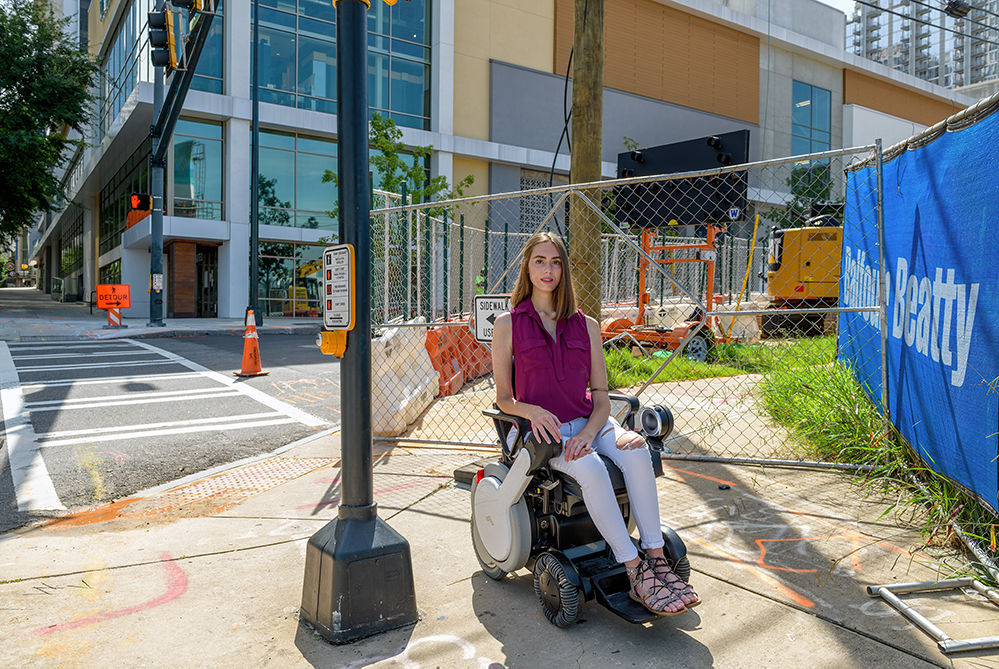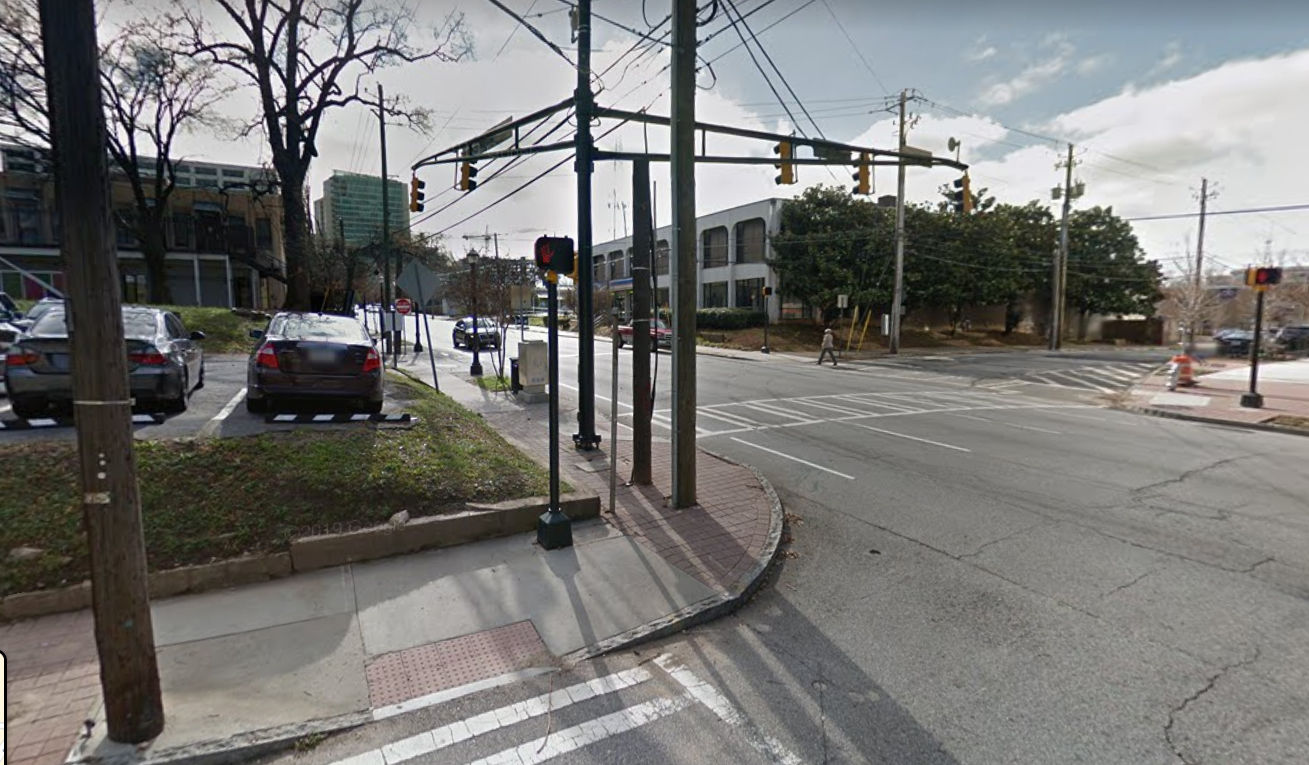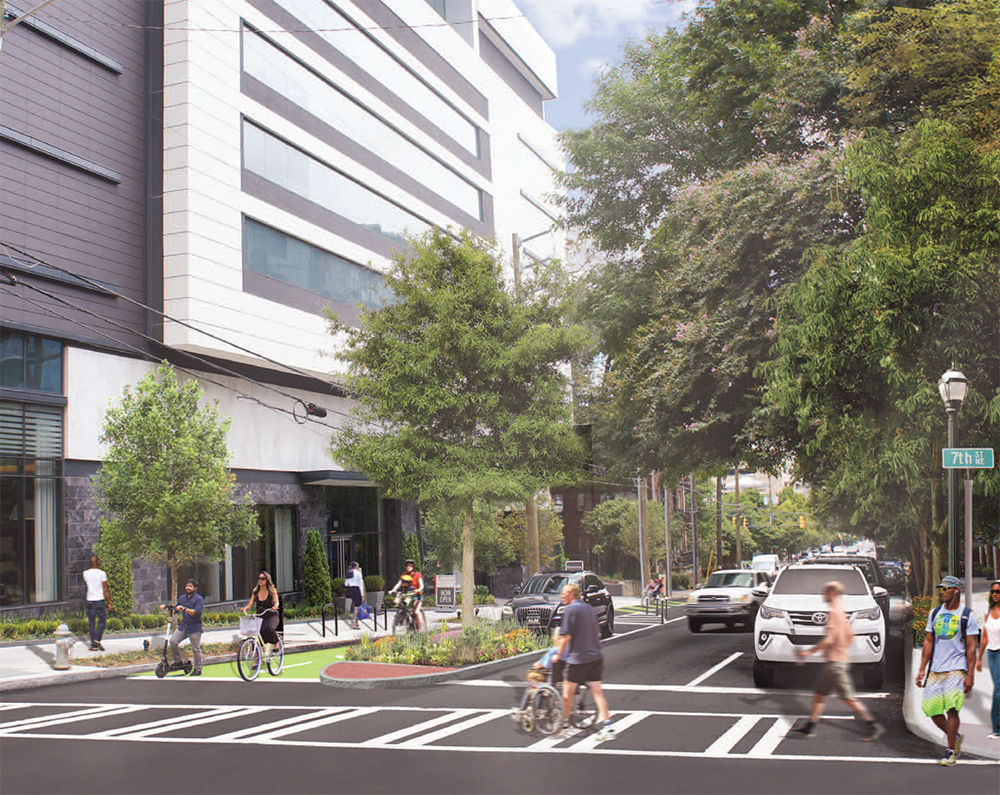As ADA Turns 30, Some Progress But Midtown Still Has Work to Do On Streets and Sidewalks
Published: 09/03/20
 Carden Wyckoff lives in Midtown and loves to ride MARTA, visit restaurants and go to the Atlanta BeltLine. But it isn't always easy to get there.
Carden Wyckoff lives in Midtown and loves to ride MARTA, visit restaurants and go to the Atlanta BeltLine. But it isn't always easy to get there.
BY ELLIE HENSLEY
Thirty years ago this summer, the Americans With Disabilities Act (ADA) was passed in an effort to equalize opportunities for people based on disability. The wide-ranging law covered areas from employment to transportation and public accommodations to access to state and local government programs.
Midtown Alliance recognizes that while some progress has been made on the ground, many of the tenets of the ADA still have not been realized. Part of our mission includes creating streets and sidewalks that work for everybody and a district that is accessible for all. To help us identify where we still have work to do, we are spending the remainder of 2020 speaking with people whose experiences can help us improve the design of our transportation network.
Atlanta native Carden Wyckoff moved from Lenox Park to Midtown in 2019. She has facioscapulohumeral muscular dystrophy, a disorder that causes progressive muscle weakness, and was riding MARTA to her job in Buckhead until the COVID-19 pandemic began and she started working from home. Despite the fact that her old apartment was closer to her office, she found that it took longer to get around when she lived in Buckhead.

“What brought me to Midtown was the central location,” Wyckoff said. “I found myself taking MARTA on the weekends after work, and I would frequent Piedmont Park and Ponce City Market.”
Being close to lots of restaurants and having access to delivery services is also key.
“It’s gotten more and more difficult to cook, so now I eat out most days,” she said. “With a disability you have to learn to adapt and change the way you’re doing things. I have a progressive disease, and with that I now have to rely on other people to cook my food for me. It’s good to be close to wonderful restaurants.”
In her current location, Carden is a five-minute roll from the Arts Center MARTA Station and close to the Whole Foods Market on 14th Street. It’s a definite improvement over her old location, which was farther away, required five elevator rides and, in inclement weather, often left her stranded in parking decks.
“Atlanta likes to have a monsoon rainstorm,” she said. “Sometimes I spent more than an hour of my day trying to get where I was going.”
Creating Public Spaces for Everyone
Despite the fact that the ADA passed a full 30 years ago and requires all new roads, sidewalks and buildings to make accommodations for people with disabilities like ramps and curb cuts, there are still parts of Midtown and the city that are difficult to get around because of legacy narrow sidewalks, utility boxes, sign posts and other clutter.
“Midtown is one of the better areas in general,” Wyckoff said. “But you’ll find some issues closer to Piedmont Park, where there are more trees. In between 13th and 14th Street on Piedmont Avenue there is an enormous tree, and it’s a trip hazard.”
Since the Midtown Improvement District was created in 2000, more than $400 million has been invested in public improvement projects and infrastructure projects including streetscapes and bridgescapes, traffic signals and parks and plazas. From November 2014 through August 2020, Midtown Alliance performed nearly $1.2 million in sidewalk “spot” repairs, including replacing concrete, building new curbs and ADA-compliant ramps. But in a rapidly densifying district with constant utility work, even maintaining the current state of the sidewalks can be a challenge.

“Improving accessibility in the public right-of-way has always been a big part of our work,” said Midtown Alliance Director of Transportation and Sustainability Dan Hourigan.” It can be difficult and expensive to meet ADA standards, but it’s imperative that we do so. We’ve made tremendous progress on accessibility, but there’s still more to be done.”
Wyckoff said the biggest challenge she faces in Midtown are the construction sites. When Wyckoff comes along a sidewalk that has been closed – or completely ripped up – with no signage or temporary route in place, it is severely limiting for her and often means she ends up with no choice but to go out into traffic. She advocates for safer design not only for herself, but others who need the sidewalks, like runners and people with strollers.
“There is so much construction in Midtown and downtown, and much of it lacks pedestrian accessibility and forethought,” she said. “Things like temporary pedestrian pathways are missing, and when an ordinance says a developer has to put a temporary pedestrian pathway, I fight to get it built.”
The Next 30 Years
The nature of a growing urban district with lots of pedestrian and vehicle traffic inherently means Midtown’s streets and sidewalks will always be a work in progress. But Midtown Alliance is working with the City of Atlanta and private developers on a number of actionable projects that will help bring the district closer to realizing the goals set forth by the ADA 30 years ago.
For example, our upcoming “Last Mile Intersections” project will install new traffic signals at seven locations and enhance pedestrian crossings at 24 intersections to enhance connectivity and safety for people accessing MARTA rail stations and local and regional bus stops.
 Plans for the Juniper Street Transformation Project, which include wider sidewalks.
Plans for the Juniper Street Transformation Project, which include wider sidewalks.
The Piedmont and Juniper Complete Streets projects will both include wider sidewalks and pedestrian-scaled lighting. These projects also include building new ADA compliant ramps.
And though the West Peachtree and Spring Quick-Build Projects, as part of Mayor Keisha Lance Bottoms Action Plan for Safer Streets are focused on LIT (light individual transport for bikes and e-scooters) lanes, Midtown Alliance has plans to improve accessibility along segments of each corridor after the City is done with its projects.
Some of these projects, such as Juniper Street, have been a long time coming, but the ADA’s 30th anniversary highlights the need to move forward on them with our partners as soon as possible.
“The anniversary of the ADA legislation is an important reminder for us to strive to do more and to demand more,” Hourigan said. “It’s also a reminder that our circumstances can change at any time and we may be the one who needs these accommodations.”
Wyckoff describes the ADA as an “incredible piece of legislation” that has improved the lives of everyone, regardless of whether they have a disability.
“Who hasn’t used an elevator or ridden or walked over a curb cut on the sidewalk?” she said. “Those came to us because of the ADA.”
Because of the act’s passage, Wyckoff said she was able to go to school with fewer inequities, have a job at an equal opportunity employer and use an accessible public transit agency like MARTA to get where she needs to go.
“We’re not perfect, and I wouldn’t be spending my time as a disability advocate if we were perfect,” she said. “We’re looking to create a more inclusive world, and we still face barriers. It really starts with using your voice.”
If you identify an accessibility issue in Midtown, let us know by emailing us.
Follow Carden on Twitter at @CardenOfMilk and check out her "Freewheelin' with Carden" podcast where she discusses accessibility issues.